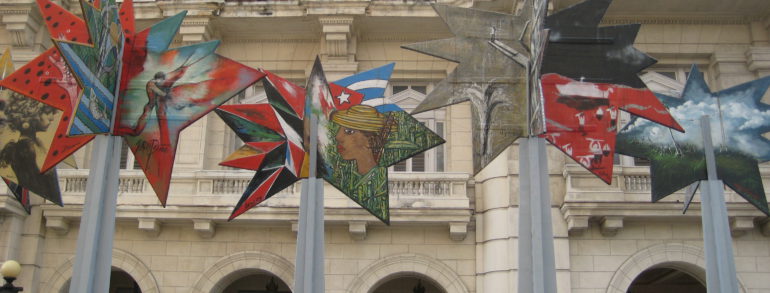El Capitolio
Opened May 1929, constructed in a local Capellania limestone, the Capitol is a small scale replica of the U.S. Capitol in Washington, D.C. At the center of its floor is set a 24-carat diamond, zero for all distance measurements in Cuba. The interior has large halls and stately staircases, all most sumptuously decorated. It served as home to Cuba's Chamber of Representatives and Senate.
The loft cupola rises 62 meters and it is topped by a replica of Florentine sculptor Giambologna's famous bronze Mercury in the Palazzo de Bargello. A massive stairway, flanked by neoclassical figures in bronze representing Labor and Virtue - lead steeply to three tall bronze doors sculpted with 30 bas-reliefs depicting important events of Cuban history.
The stunning Salon de los Pasos Perdidos is made entirely of Marble, with bronze bas reliefs all around and massive lamps on tall carved copper stands. Facing the entrance door is the third largest indoor statue in the world, a Cuban maiden resembling Liberty and representing the Cuban Republic.
Entrance to the left of the stairway; $1 USD to go in the halls, $3 USD for a tour.
Parque Central
A very pleasant park, shaded by royal palms (Cuba's National Tree), poincianas and almond trees with monument to José Martí in the centre. Very lively at all times with locals who often gather at one of the park corners to discuss baseball and politics.
Partagas Cigar Factory
Located on Calle Industria behind the Capitolio, gives tours twice daily, in theory, at 10:00 am and 1:30 pm, $5 USD. The tour lasts for about an hour and is very interesting. You are taken through the factory and shown the whole production process from storage and sorting of leaves, to packaging and labeling (explanation in Spanish only). Four different brand names are made here; Partagas, Cubana, Ramón Allones and Bolìvar.
These and other famous cigars can be bought at their shop here, open 9:00 am - 5:00 pm, and rum, at good prices. Cigars are also made at many tourist locations (eg Palacio de la Artesanìa, the airport, some hotels).
Gran Teatro de la Habana
Constructed in 1847, the Teatro Garcia Lorca was built as a social club for the large Galician community with an exorbitantly baroque facade. It has four towers, each tipped by an angel of white marble reaching gracefully for heaven. They can be best appreciated and photographed from the rooftop of the neighboring Inglaterra Hotel. With its red velvet seats, it still functions as a theatre for the Ballet Nacional de Cuba and Opera. The marble staircase to the main hall is magnificent and the mahogany woodwork at the cafeteria is remarkable.
Presidential Palace (1922)
A huge, ornate building topped by a dome, facing Av de las Misiones; now contains the Museo de la Revolución (T 62-4091). Open Tues-Sun 10:00 am - 5:00 pm, entrance $3 USD, cameras allowed, $3 USD extra. (Allow several hours to see it all, explanations are all in Spanish.) The history of Cuban political development is charted, from the slave uprisings to joint space missions with the ex-Soviet Union. The liveliest section displays the final battles against Batista's troops, with excellent photographs and some bizarre personal mementoes from the Sierra Maestra campaign. At the top of the main staircase are a stuffed mule and a stuffed horse used by Che Guevara and Camilo Cienfuegos. The yacht Granma, from which Dr Castro disembarked with his companions, in 1956, to launch the Revolution, has been installed in the park facing the south entrance. It is surrounded by planes, tanks and other vehicles involved, as well as a Soviet-built tank used against the Bay of Pigs invasion and a fragment from a U.S. spy plane shot down in the 1970s.
Museum of the Revolution and Granma Memorial
The luxurious mansion that was the residence of the Presidents of the Republic, between 1920 and 1960, now holds the Museum of the Revolution, devoted to the national rebellion of the Cuban people.
Its halls contain a detailed panorama of the country's struggles for national sovereignty in a historical discourse supported by abundant testimonial material made up of photographs, original documents, mock- ups, weapons, personal belongings of revolutionary fighters, recordings, videos and films. Adjacent to the Museum is the "Granma Memorial," the immense glass case holding the yacht used by Fidel Castro and over 80 revolutionary fighters to return to Cuba from their exile in Mexico.
The landing took place on December 2, 1957, at a point on the southern coast of Oriente Province, marking the beginning of the Liberation War in the Sierra Maestra Mountains.
Collections: History of Cuba; Archaeology; Weapons.
Address: Refugio No 1 e/ Monserrate y Zulueta, La Habana Vieja
Open: Tuesday to Saturday: 1:00 pm to 6:00 pm, Sundays: 10:00 am to 1:00 pm, Closed Mondays

